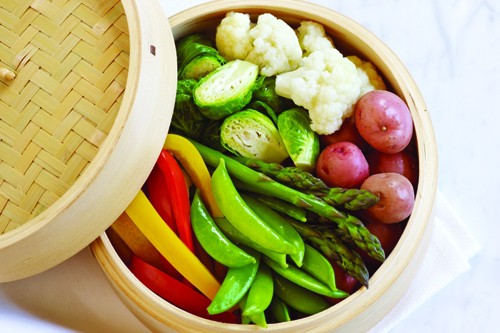
There’s no more iconic health food than a perfectly steamed vegetable or piece of fish. But while health fanatics embrace steamed food, many people do not. Commonly regarded as a boring or flavorless method of preparing food, steaming has a bad reputation. Enter the bamboo steamer, a kitchen tool that cooks food gently without destroying flavor or nutrients. A bamboo steamer is an inexpensive way to turn steamed food’s harshest critics into believers.
Cooking with bamboo steamers is a great way to prepare food without compromising its nutritional integrity. By using steam alone, food is cooked without requiring high heat or direct contact with water, which can destroy nutrients. No butter, oil or other fat is needed.
Bamboo steamers originated in China thousands of years ago and as a result are often associated exclusively with Chinese cooking. However, the bamboo steamer is more than just a vessel to prepare dim sum. The steamer’s construction makes it a great tool for cooking fish, vegetables and meat.
Bamboo steamers are round containers, typically about 10 inches wide and six inches high, with an open-weave bottom and a domed lid. The open-weave construction allows steam through, while the domed lid traps and circulates the steam. This results in a delicate cooking technique that locks in flavor while keeping food moist and tender. Bamboo steamers are unique because they can be stacked during use, allowing multiple foods to be cooked at the same time.
The steamer is easy to use. First, choose a wok or other pot that is large enough for the steamer to sit on top or nestle against the sides, but not so large that the steamer sits on the bottom of the pot. Fill the wok or pot with water, measured to about an inch from the bottom of the steamer, and bring to a boil. Once the water is boiling, place the food inside the steamer and set the steamer on top of the boiling water. Steam the food as desired.
With a bamboo steamer on hand, it’s easy to transform plain old steamed food into something truly delicious and satisfying.
Bamboo Steamer Tips
- If steaming foods in separate trays, place the food that will take longest to cook on the bottom tray, closer to the heat source. When steaming vegetables like broccoli or asparagus, point the tougher, thicker ends toward the middle of the steamer — the produce will cook more evenly.
- Place sticky foods on parchment paper, a plate or aluminum foil (but don’t completely cover the bottom) to prevent them from adhering to the steamer. Cabbage leaves, banana leaves or corn husks can also be used as liners and to add flavor.
- Line your steamer when steaming fish to prevent the scent from infusing the wood.
- When cooking fish or meat, leave enough space around each piece for the steam to circulate. This helps the meat cook evenly.
- Try steaming food over broth instead of water. This imparts the food with subtle flavor.
- Layer fresh herbs or aromatics between vegetables or protein for added flavor without salt.
- Revive day-old bread in your steamer. Wrap it in foil and steam for three to five minutes.
- Cautiously remove the lid when finished steaming; the trapped steam can be dangerously hot.
- Care for your steamer by washing it in warm, soapy water and then rinse and air dry. Once the steamer is completely dry, store it in a well-ventilated area. Never put a steamer in a dishwasher and don’t soak it.





